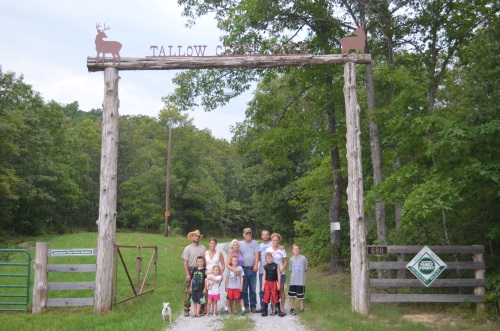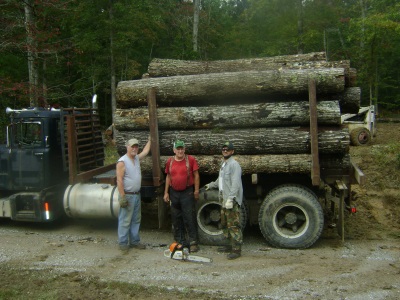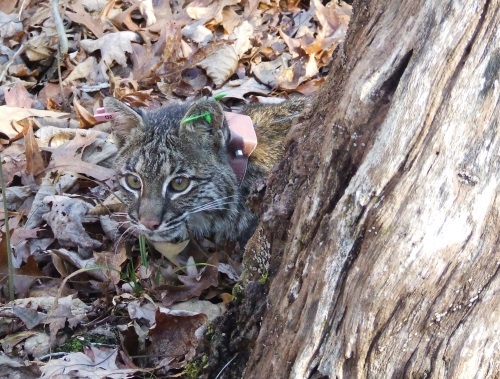Harry and Karen Pelle of Kentucky

What makes them outstanding?
What makes the Pelles’ tree farm outstanding? Mr. Pelle’s tree farm is not only his passion, but it is his lifestyle. This tree farmer truly lives the life of a tree farmer. Everyday he wakes up (early) and goes out into his farm to manage the forest resource. Not only does he perform the labor involved to mange the forest, he also brings his family and many other individuals onto his farm to utilize, experience, and maintain the wonderful resources that the forest provides. His passion and enthusiasm for the forest spills over to his neighbors that have been influenced by Harry’s actions to be good stewards and have performed several management practices upon their farms. The farm is multi-generational. In addition to Harry and Karen, their daughter and son-in-law and their children also live and work on the farm. There are 3 generations of tree farmers living on the farm and the tree farm is the center of their daily lives. Harry is able to teach his daughter, son-in-law, and grandchildren first hand what it truly means to be a tree farmer. This multi-generational lifestyle of tree farming and knowing that the spirit of the tree farm is going to carry on thru the generations is really what makes the Pelle tree farm outstanding.
Tree Farmer Story
 In 1982 my Dad, Ray Pelle,
bought the first 400-acre piece of this Farm as a place for us to hunt. We had
been deer hunting on public land for a few years and wanted our own place away
from the crowds. Over time, Harry and Ray went in together on several hundred
more adjoining acres, as it became available. Ray eventually retired but then
passed away a couple of years later in 2003. Karen and Harry continued to
purchase adjoining property, as it became available until the farm had grown to
its present size of over 1,500 acres.
In 1982 my Dad, Ray Pelle,
bought the first 400-acre piece of this Farm as a place for us to hunt. We had
been deer hunting on public land for a few years and wanted our own place away
from the crowds. Over time, Harry and Ray went in together on several hundred
more adjoining acres, as it became available. Ray eventually retired but then
passed away a couple of years later in 2003. Karen and Harry continued to
purchase adjoining property, as it became available until the farm had grown to
its present size of over 1,500 acres.
Over the years we progressed from weekend stays in Pup tents...upgraded to popup campers, then regular campers and Grandpa's Mobile Home converted to a deer hunter’s abode. Grandparents Ray and JoAnn built a nice cabin that they could stay in on weekends and spend longer stays when he retired. Harry and Karen built the Main house in 1996 in hopes of retiring here some day. We ran water and electric where none had been before, 1 mile back from the main road. Then our daughter and son in law, Kim and Shane, built their Log Home in 2004 and moved to the Farm to start their family. Eventually Harry retired in 2008 and he and Karen moved to the Farm. We’ve come a long way from the Pup tent days.
Most of the properties we bought along the way had been recently logged. About the only way we could afford to buy this much property. This was good woods for deer hunting with a lot of young natural regeneration trees. In an effort to improve our habitat we contacted KDFWR and had a Wildlife Biologist come out and make recommendations on improving the habitat for Wildlife. One of the Biologist recommendations was to have a Kentucky Department of Forestry Forester come out and develop a Forest Stewardship Plan. Over time we became interested not only hunting but became deeply interested in Forestry. Leading to many, many seminars on Forestry and much good exposure to U of K Dept. of Forestry and the Kentucky Woodland Owners Association.
In order to develop a more detailed
plan for improving our forest we began a relationship  with a local Consulting
Forester (Chris Will). We felt in order to design a plan specific to our
property, the first thing we needed to determine going forward was where we
were. So we had a Timber inventory done of our farm that enabled us to drive a
stake in the ground and know exactly what we had. This enabled us to better
plan on where we wanted to go and better pick options on how to get there.
with a local Consulting
Forester (Chris Will). We felt in order to design a plan specific to our
property, the first thing we needed to determine going forward was where we
were. So we had a Timber inventory done of our farm that enabled us to drive a
stake in the ground and know exactly what we had. This enabled us to better
plan on where we wanted to go and better pick options on how to get there.
These properties had not only been recently logged but they had been put through generations of "High Grading". Through this Education process we learned of financial help through NRCS to help bring the logged over and High Graded woods back into a working sustainable Forest and ecosystem. To date we have done over 300 acres of TSI. By hand the only way it can be done.
TSI is a wonderful thing that not only improves the woods, but improves the woodsman. You learn your property inch by inch, tree by tree, and you learn about the health of your woods and a host of other issues that help you build a better plan to improve your farm. Things like where you need a culvert, where places are starting to erode and need help etc. You see places for potential new access roads or new trails. You spot invasive species as they are starting (enabling you to get them under control while it is still possible). You see game and find Game trails. You learn your Boundary well and you spot Boundary issues before they get out of hand. You see many tree health issues you would never notice from the truck or an ATV. They say the Best thing for a tract of woods is "the tracks of the owner" and I am a firm believer of that.
On holiday weekends the farm has long been a gathering place for our family. One of our daughters, and her family, still live in Louisville KY. We have many friends and family, grandkids, aunts, uncles and cousins that come to swim in the ponds, ride ATV’s, fish and have cook outs. It is not unusual for us to have 40 or 50 friends and family on a good weekend.
We continue expanding on Grandpa’s vision of "a place to hunt" to the place Tallow Creek Farm has become today. A place for many to hunt, a Homeplace to our family (Three generations now live permanently on the farm.) a special gathering Place to many families (and final resting-place for some), a Certified Tree Farm. Over the years we have won many awards. The 2012 Kentucky Forest Stewards of the year. The 2013 Kentucky State Tree Farmer of the Year. The 2014 Kentucky Department of Fish and Wildlife resources State Landowner of the year. We are very proud of all the awards we have won, but the most rewarding thing we get from the tree farm is watching the trees and our family grow together. It’s a wonderful place to raise a family.
Wood
The woodland had a long history of logger choice harvests and occasional wildfire before it was acquired by the Pelles’. The resulting woodland was mostly small to medium sawtimber with a large percentage of trees that were cull, low quality or of less desirable species. The Pelles’ have been working to improve the quality of the timber for the future. More than 300 acres of crop tree release, cull tree removal, and mid-story removal for regeneration have been accomplished. The practices were mostly accomplished with cost-share assistance, marked by the Kentucky Division of Forestry and the work completed by the family.
Dead and low quality trees have been harvested for firewood and a small (1,100bf) salvage harvest was completed.
The stands are maturing and when the stand conditions warrant, timber harvests will be planned. Maximizing long term timber productivity is a goal of the Pelles’. They have started a American Chestnut restoration orchard on the property.
Water
The Pelles started construction on their first pond around 1983. Kentucky Department Fish and Wildlife Resources helped with picking the location and the pond design. Since then the Pelles have added or enhanced a total of seven ponds on their property using KDFWR for stocking fish.
The Pelles spend a lot of time swimming, fishing and frog gigging their ponds. In the summer their children, grandchildren and the Boy Scouts love to ride the zip line on the main pond. The main pond at the Pavilion is the center of activity at Tallow Creek Farms.
The Pelles daughter and son-in-law use water from one of the ponds to supply their family’s water needs for their log cabin home. They use it for drinking water and other household needs. The pond also supplies water to their outside wood burning boiler and heats their home with radiant heat through the pipes that run under their floors. Mr. Pelle is planning to convert his home to using the pond water like his daughter and son-in-law. He likes the idea of drinking his own chemical free water and he thinks it tastes better!
They have a dozer and other equipment that they use to maintain their ponds and the road system. They install and maintain water bars, cut outs and culverts to protect the water resources on the farm. They are maintaining about 15 miles of roads and trails.
The Pelles have used the Conservation Reserve Program (CRP) on projects such as Filter Strips and Filter Borders. They have also converted old crop fields to native grasses under WHIP. These practices help wildlife and enhance water quality on the farm and for people down stream.
Wildlife
Being conservation minded, the Pelle's have enhanced and maintained wildlife habitat that complements their forest management. Using the Conservation Reserve Program, 12.3 acres have been planted to cool season grasses and legumes as filter strips along streams on the farm; and 19.2 acres have been planted to native warm season grasses and wildflowers along field borders creating buffers for declining northern bobwhite (quail). Using the Wildlife Habitat Incentives Program, 25 acres have been planted to native warm season grasses and wildflowers creating additional habitat for northern bobwhite and other grassland birds. Approximately 1,345 acres of forest habitat has been enrolled in the Conservation Stewardship Program with enhancements that include the establishment of pollinator habitat and placement of wood duck nesting boxes.
Approximately 25 acres of wildlife food plots are maintained for deer, turkey, northern bobwhite, and rabbit. Open habitat on the property that has been planted to native warm season grasses and wildflowers is managed by mowing and the use of prescribed fire. The 300 acres of forest stand improvements that have been completed on the property not only benefit future timber resources, but also benefit forest wildlife. Neo-tropical migrants and other forest songbirds benefit from diverse multilayered forest canopy habitat and the creation of snags and cavity trees. Game species such as deer, turkey, and squirrels benefit from increased hard mast production created by favoring oaks, as well as increased browse, cover, and soft mast stimulated by opened forest canopies.
Recreation
The Pelles spend a lot of time swimming, fishing and frog gigging their ponds. In the summer their children, grandchildren and the Boy Scouts love to ride the zip line on the main pond. The Pavilion at the main pond is the center of activity at Tallow Creek Farms. The Family has gatherings at the outdoor pavilion most weekends including a large fall festival where 50 or so kids (and many parents) come for hay rides and scavenger hunts and walks in the woods. They have an annual Derby day “Duck Derby” in Tallow Creek for the kids.
The Boy scouts come out for weekend camps including rifle range and shotgun shooting. An ex-Army Ranger son in law that lives on the farm, has a company called Leading Concepts, that teaches companies leadership, teamwork and communication skills based on Army Ranger techniques. He takes clients on exercises into the woods for 4 days at a time (there have been several Magazine articles on this). The farm has been used as a training area for rescue dogs to find lost people in the woods. Their daughter’s physical therapy business offers opportunities for individuals with developmental disabilities to safely explore and learn through interaction with nature.
The farm is home to many hunters for much of the fall and winter. Much of the management efforts go toward enhancing wildlife habitat.


